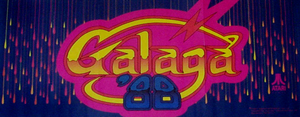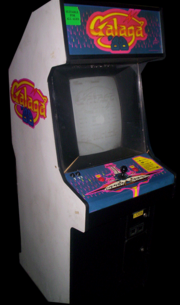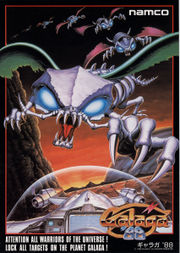Lost In Translation/Galaga '88
| Galaga '88 | |
|---|---|
| Manufacturer | Namco |
| Released | 1987 |
| Control Method |
8-way Joystick 3 Button(s) |
| Main CPU | (3x) M6809 (@ 1.536 MHz) HD63701 (@ 1.536 MHz) |
| Sound CPU | Stereo YM2151 (@ 3.580 MHz) Namco CUS30 (@ 12.000 kHz) DAC |
| Video Details |
Raster (Vertical) 288 x 224 pixels 60.61 Hz 8,192 Palette colours |
| Screens | 1 |
| ROM Info | 25 ROMs 2,297,856 bytes (2.19 MiB) |
| MAME ID | galaga88 · galag88j |
About The Game
Galaga '88 is an arcade video game shoot-em-up, which is an updated version of the old favorite, Galaga, with more invaders and more player firepower. Galaga '88 gives players a chance to once again repel the invaders from the Galagan Kingdom. One or two players can try their hand at fighting the invaders. This time the Galagans have four more allies, each with unique weapons and defenses that a player must overcome.
By destroying special enemies or obstacles the player can get 'items'. When a player has two items, he can warp to another sector to confront more Galagan ships with new strategies. In the Challenge Rounds, the player shoots down as many invaders as possible as the Galagans dance to a waltz, tango, march or jazz tune.
The player selects single or dual ship power. The objective is to destroy all the Galagan foes in each of the 29 sectors of the galaxy, with each sector more difficult than the last.
Unique Features :
- More opponents. In addition to Boss, Goei and Zago, the original Galagan crew, Don, Nin, Ban, and Gan have been added. Each of the Galagans has a unique way of challenging the players.
- Different types of ships. Players can choose single or dual ships (if the game option is set for dual and single). When the player retrieves a dual ship from the Boss's tractor beam, it turns into a triple ship with ten times the power of a single ship.
- Challenge Rounds. In the Galaga '88 Challenge Rounds the Galagan invaders dance to a waltz, tango, Sousa march or jazz tune, while the player shoots down Galagans to earn bonus points.
- Warping to a new sector. By destroying particular enemies or obstacles and capturing two of their items, the player can warp to the next sector.
- Player challenge. Each sector has different mix of Galagans with different strategies to be overcome.
- Win back captured ships. The player can win back ships captured in the Boss Galaga's tractor beam. When the player destroys the Boss, the ships are released. If the player retrieves them, the ships become dual ships if they were single and triple if they were double.
- High Score Mode. Upon completing a game, a player can enter his initials if he is among the top eight scorers on the game.
Trivia
Released in December 1987.
Licensed to Atari for US distribution.
An homage to "Bosconian" is paid in stages 15-17 (dimension 4) with the green hexagonal space stations in the background, as well as the mines which are used as scenery objects.
Challenging Stage 2 from Dimension 1 is used as a loading game in "Ridge Racer Revolution".
Stephen Krogman holds the official record for this game with 1,575,490 points.
Tips and tricks
- Perfect Bonus : shoot all 40 enemies in the 'That's Galactic Dancin' bonus stages to receive a 'Perfect' bonus just like the challenging stages in the original "Galaga". Initially this bonus is 10,000 points but it increases on later 'That's Galactic Dancin' stages.
- Secret Bonus : during the 'That's Galactic Dancin' bonus stage, don't touch anything : don't shoot and don't move (simply don't touch the joystick); at the end of the dance and after getting ZERO hits and ZERO points, you'll receive a 10,000 points 'Secret Bonus'.
- Pick up two blue items to get a bonus and go to the next harder dimension after completing a 'That's Galactic Dancin' stage. This bonus is also initially 10,000 points but increases each time you achieve it.
- Pick up a purple item which appears on later stages to immediately get a triple firepower ship.
Series
- Galaxian (1979)
- Galaga (1981)
- Gaplus (1984) also known as "Galaga 3".
- Galaga '88 (1987)
- Galaxian3 (1990)
- Galaxian3 Theatre 6 : Project Dragoon (1990)
- Galaxian3 Theatre 6 J2 : Attack Of The Zolgear (1994)
- Galaga - Destination Earth (2000, Nintendo Game Boy Color, PC CD-ROM and Sony PlayStation)
- Galaga Legions (2008, XBOX 360 [Xbox Live Arcade])
Staff
- Sound Composed By
- Hiroyuki Kawada
Cabinet and Artwork
Ports
- Consoles
- NEC PC-Engine (1988)
- Sony PlayStation (1995, "Ridge Racer Revolution") (Plays the game while the main game loads.)
- Sony PlayStation 2 (2005, "Namco Museum 50th Anniversary")
- Microsoft XBOX (2005, "Namco Museum 50th Anniversary")
- Nintendo GameCube (2005, "Namco Museum 50th Anniversary")
- Computers
- Commodore Amiga ("Deluxe Galaga")
- Sharp X68000 (1990)
- PC [MS Windows, CD-ROM] (2005, "Namco Museum 50th Anniversary")
Soundtrack Releases
| Album Name | Catalogue No. | Released | Publisher | Comments |
|---|---|---|---|---|
| Namco Video Game Graffiti Volume 3 | VDR-5278[1] | 1988-12-16 | Victor | CD version. |
| Namco Video Game Graffiti Volume 5 | VDR-5300[2] | 1989-08-21 | Victor | CD version. |
| Dragon Spirit - Emotional Sound of Namcot | BY30-5208[3] | 1989-02-05 | APOLLON | CD version. |
| Dragon Spirit - Emotional Sound of Namcot | KY25-0001[4] | 1989-02-05 | APOLLON | Cassette version. |
| Namco Video Game Graffiti Volume 3 | VCH-1905[5] | 1988-12-16 | Victor | Cassette version. |
| Namco Video Game Graffiti Volume 3 | SJX-25049[6] | 1988-12-16 | Victor | Vinyl version. |
| Namco Video Game Graffiti Volume 5 | VCH-1913[7] | 1989-08-21 | Victor Musical Industries | Cassette version. |
| Beep Special Project - SUPER GAME MUSIC | N/A[8] | 1988-07-01 | Softbank Publishing | Vinyl version. |
References
- ↑ Namco Video Game Graffiti Volume 3 (CD) at the VGMdb
- ↑ Namco Video Game Graffiti Volume 5 (CD) at the VGMdb
- ↑ Dragon Spirit - Emotional Sound of Namcot (CD) at the VGMdb
- ↑ Dragon Spirit - Emotional Sound of Namcot (Cassette) at the VGMdb
- ↑ Namco Video Game Graffiti Volume 3 (Cassette) at the VGMdb
- ↑ Namco Video Game Graffiti Volume 3 (Vinyl) at the VGMdb
- ↑ Namco Video Game Graffiti Volume 5 (Cassette) at the VGMdb
- ↑ Beep Special Project - SUPER GAME MUSIC (Vinyl) at the VGMdb







